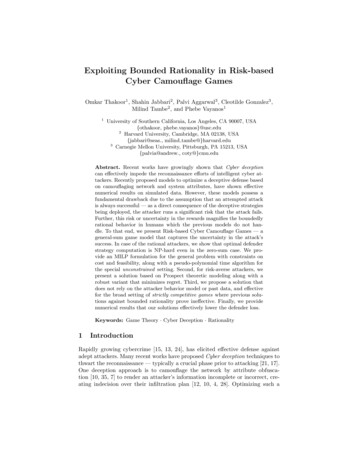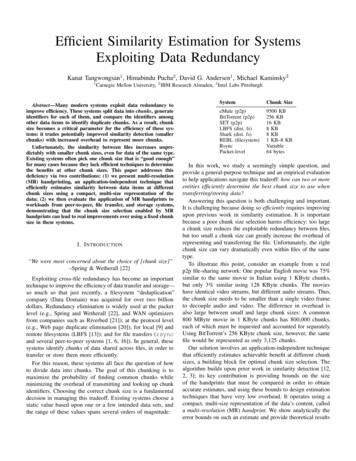
Transcription
Exploiting Bounded Rationality in Risk-basedCyber Camouflage GamesOmkar Thakoor1 , Shahin Jabbari2 , Palvi Aggarwal3 , Cleotilde Gonzalez3 ,Milind Tambe2 , and Phebe Vayanos11University of Southern California, Los Angeles, CA 90007, USA{othakoor, phebe.vayanos}@usc.edu2Harvard University, Cambridge, MA 02138, USA{jabbari@seas., milind tambe@}harvard.edu3Carnegie Mellon University, Pittsburgh, PA 15213, USA{palvia@andrew., coty@}cmu.eduAbstract. Recent works have growingly shown that Cyber deceptioncan effectively impede the reconnaissance efforts of intelligent cyber attackers. Recently proposed models to optimize a deceptive defense basedon camouflaging network and system attributes, have shown effectivenumerical results on simulated data. However, these models possess afundamental drawback due to the assumption that an attempted attackis always successful — as a direct consequence of the deceptive strategiesbeing deployed, the attacker runs a significant risk that the attack fails.Further, this risk or uncertainty in the rewards magnifies the boundedlyrational behavior in humans which the previous models do not handle. To that end, we present Risk-based Cyber Camouflage Games — ageneral-sum game model that captures the uncertainty in the attack’ssuccess. In case of the rational attackers, we show that optimal defenderstrategy computation is NP-hard even in the zero-sum case. We provide an MILP formulation for the general problem with constraints oncost and feasibility, along with a pseudo-polynomial time algorithm forthe special unconstrained setting. Second, for risk-averse attackers, wepresent a solution based on Prospect theoretic modeling along with arobust variant that minimizes regret. Third, we propose a solution thatdoes not rely on the attacker behavior model or past data, and effectivefor the broad setting of strictly competitive games where previous solutions against bounded rationality prove ineffective. Finally, we providenumerical results that our solutions effectively lower the defender loss.Keywords: Game Theory · Cyber Deception · Rationality1IntroductionRapidly growing cybercrime [15, 13, 24], has elicited effective defense againstadept attackers. Many recent works have proposed Cyber deception techniques tothwart the reconnaissance — typically a crucial phase prior to attacking [21, 17].One deception approach is to camouflage the network by attribute obfuscation [10, 35, 7] to render an attacker’s information incomplete or incorrect, creating indecision over their infiltration plan [12, 10, 4, 28]. Optimizing such a
2Thakoor et al.deceptive strategy is challenging due to many practical constraints on feasibility and costs of deploying, as well as critically dependent on the attacker’sdecision-making governed by his behavioral profile, and attacking motives andcapabilities. Game theory offers an effective framework for tackling both theseaspects and has been successfully adopted in security problems [2, 20, 31, 29].Attacking a machine amounts to launching an exploit for a particular systemconfiguration — information that is concealed or distorted due to the deceptive defense, thus, an attempted attack may not succeed. Recent game theoreticmodels for deception via attribute obfuscation [30, 34] have a major shortcomingin ignoring this risk of attack failure as they assume that an attempted attack isguaranteed to provide utility to the attacker. Further, results from recent humansubject studies [1] suggest that this risk may unveil risk-aversion in human attackers rather than a perfectly rational behavior of maximizing expected utilitythat the models assume. Apart from risk-aversion, other behavioral models, e.g.,the Quantal response theory [22], also assert that humans exhibit bounded rationality. This can severely affect the performance of a deployed strategy, whichhas not been considered by the previous works.As our first main contribution, we present Risk-based Cyber CamouflageGames (RCCG) — a crucial refinement over previous models via redefined strategy space and rewards to explicitly capture the uncertainty in attack success. Asfoundation, we first consider rational attackers and show analytical results including NP-hardness of optimal strategy computation and its MILP formulationwhich, while akin to previous models, largely require independent reasoning. Further, we consider risk-averse attackers modeled using Prospect theory [36] andpresent a solution (PT ) that estimates model parameters from data to computeoptimal defense. To circumvent the limitations of parametrization and learning errors, we also present a robust solution (MMR) that minimizes worst-caseregret for a general prospect theoretic attacker. Finally, we propose a solution(GEBRA) free of behavioral modeling assumptions and avoiding reliance on dataaltogether, that can exploit arbitrary deviations from rationality. Our numericalresults show the efficacy of our solutions summarized at the end.1.1Related workCyber Deception Games [30], and Cyber Camouflage Games (CCG) [34] aregame-theoretic models for Cyber deception via attribute obfuscation. In these,the defender can mask the true configuration of a machine, creating an uncertainty in the associated reward the attacker receives for attacking the machine.These have a fundamental limitation, namely, the assumption that the attackedmachine is guaranteed to provide utility to the attacker. Further, they do notconsider that human agents tend to deviate from rationality, particularly whenmaking decisions under risk. Our refined model handles both these crucial issues.A model using Prospect theory is proposed in [38] for boundedly rationalattackers in Stackelberg security games (SSG) [33]. However, it relies on usingmodel parameters from previous literature, discounting the fact that they canlargely vary for the specific experimental setups. We provide a solution thatlearns the parameters from data, as well as a robust solution to deal with uncer-
Exploiting Bounded Rationality in Risk-based Cyber Camouflage Games3tainty in the degree of risk-aversion and broadly the parametrization hypothesis.A robust solution for unknown risk-averse attackers has been proposed for SSGsin [27], however, it aims to minimize the worst-case utility, whereas, we takethe less conservative approach of minimizing worst-case regret. Previous workson uncertainty in security games consider Bayesian [18], interval-based [19], andregret-based approaches [23], however, these do not directly apply due to fundamental differences between RCCGs and SSGs as explained in [34].Another approach in [38] is based on the Quantal Response model [22]. However, the attack probabilities therein involve terms that are exponential in rewards, which in turn are non-linear functions of integer variables in our model,leading to an intractable formulation. However, we show effectiveness of ourmodel-free solution for this behavior model as well.Machine learning models such as Decision Tree and Neural Networks havebeen used for estimating human behavior [8]. However, the predictive powerof such models typically comes with an indispensable complexity (non-linearkernels, functions and deep hidden layers of neural nets, sizeable depth andbranching factor of decision trees etc). This does not allow the predicted humanresponse to be written as a simple closed-form expression of the instance features,viz, the strategy decision variables, preventing a concise optimization problemformulation. This is particularly problematic since the alternative of searchingfor an optimal solution via strategy enumeration is also non-viable — due to thecompact input representation via a polytopal strategy space [16] in our model.MATCH [25] and COBRA [26] aim to tackle human attackers in SSGs thatavoid the complex task of modeling human decision-making and provide robustness against deviations from rationality. However, their applicability is limited— in Strictly Competitive games where deviation from rationality always benefits the defender, they reduce to the standard minimax solution. Our model-freesolution GEBRA on the other hand, achieves better computational results thanminimax, and MATCH can be seen as its conservative derivative.2Risk-based Cyber Camouflage Games (RCCG) modelHere, we describe the components of the RCCG model, explicitly highlightingthe key differences with respect to the CCG model [34].Network Configurations. The network is a set of k machines K : {1, . . . , k}.Each machine has a true configuration (TC), which is simply an exhaustive tupleof attributes so that machines having the same TC are identical. S : {1, . . . , s}is the set of all TCs. The true state of the network (TSN) is a vectorP n (ni )i Swith ni denoting the number of machines with TC i. Note that i S ni k.The defender can disguise the TCs using deception techniques. Each machineis “masked” with an observed configuration (OC). The set of OCs is denoted byT . Similar to a TC, an OC corresponds to an attribute tuple that fully comprisesthe attacker view, so that machines with the same OC are indistinguishable.Deception Strategies. We represent the defender strategy as an integer matrixΦ, where Φij is the no. of machines with TC i, masked with OC j. The observed
4Thakoor et al.state of the networkP (OSN) is a function of Φ, denoted as m(Φ) : (mj (Φ))j T ,where mj (Φ) i Φij denotes the no. of machines under OC j for strategy Φ.Deception feasibility and costs. Achieving deception is often costly and not arbitrarily feasible. We have feasibility constraints given by a (0,1)-matrix Π, whereΠij 1 if a machine with TC i can be masked with OC j. Next, we assume thatmasking a TC i with an OC j (if so feasible), has a cost of cij incurred by thedefender, denoting the aggregated cost from deployment, maintenance, degradedfunctionality, etc. We assume the total cost is to be bounded by a budget B.These translate to linear constraints to define the valid defender strategy set: Φij Z 0 , Φij Πij ni (i, j) S T , F Φ P Φ n i S, P P Φ c Bijiij ij j Ti S j TThe first and the third constraints follow from the definitions of Φ and n. Thesecond imposes the feasibility constraints, and the fourth, the budget constraint.Remark 1. The budget constraint can encode feasibility constraints as a specialcase by setting a cost higher than the budget for an infeasible masking. The latterare still stated explicitly for the useful interpretation and practical significance.Defender and Attacker Valuations. A machine with TC i gets successfully attacked if the attacker uncovers the disguised OC and uses the correct exploitcorresponding to TC i. In such a case, the attacker gets a utility vi — his valuation of TC i. Collectively, these are represented as a vector v. Analogously, wedefine valuations u representing the defender’s loss.Remark 2. For ease of interpretation, we assign a 0 utility to the players whenthe attack is unsuccessful, which sets a constant reference point. Hence, unlikeCCGs, valuations cannot be freely shifted. Further, a successful attack typicallyis undesirable for the defender (except, e.g., honeypots), and to let the valuationsbe typically positive values, they represent the defender’s loss; its minimizationis the defender objective unlike maximization in CCGs.Attacker Strategies. As the attacker cannot distinguish between machines withthe same OC, he chooses an OC from which to attack a random machine. Attacking a machine requires choosing an exploit to launch for a particular TC.Thus, the attack can be described as a pair of decisions (i, j) S T . Thissignificant difference in attack strategy space definition and the imminent playerutility definitions as a consequence, cause the fundamental distinction in thepractical scope as well as the technical solutions of the RCCG model.We model the interaction as a Stackelberg game to capture the order ofplayer decisions. The defender is the leader who knows the TSN n and candeploy a deception strategy Φ, and the attacker chooses a pair (i, j) S T .The defender can only play a pure strategy since it is typically not possible tochange the network frequently, making the attacker’s view of the network static.As in Schlenker et al. [30], Thakoor et al. [34], we assume the attacker can use the
Exploiting Bounded Rationality in Risk-based Cyber Camouflage Games5defender’s strategy Φ to perfectly compute the utilities from different attacks,which is justified via insider information leakage or other means of surveillance.Suppose the defender plays a strategy Φ, and the attacker attacks using an exploit for TC i on a machine masked with OC j. Among mj (Φ) machines maskedby OC j, Φij are of TC i. Hence, the attack is successful with a probabilityΦijmj (Φ) . Consequently, the player utilities are given byΦijΦijU a (Φ, i, j) vi , U d (Φ, i, j) ui .(1)mj (Φ)mj (Φ)Note that these expressions imply that if the player valuations (v or u) aresimultaneously scaled by a positive constant (for normalization etc.), it preservesthe relative order of player utilities, and in particular, the best responses to anystrategies, thus keeping the problem equivalent.Next, we show analytical results on optimal strategy computation for a rational attacker, which lay the foundation for further tackling bounded rationality.3Rational attackersThe attacker having to choose a TC-OC pair as an attack here rather than just anOC as in the CCG model [34], requires entirely new techniques for our analyticalresults, despite close resemblance in the optimization problem as below.Optimization problem Previous work on general-sum Stackelberg games hastypically used Strong Stackelberg equilibria (SSE). This assumes that in case ofmultiple best responses, the follower breaks ties in favor of the leader (i.e., minimizing defender loss). The leader can induce this with mixed strategies, whichis not possible in RCCGs as the defender is restricted to pure strategies [14].Hence, we consider the worst-case assumption that the attacker breaks tiesagainst the defender, leading to Weak Stackelberg Equilibria (WSE) [6]. WSEmay not always exist [37], but it does when the leader can only play a finite setof pure strategies as in CCG. Hence, we assume that the attacker chooses a bestresponse to the defender strategy Φ, maximizing the defender loss in case of atie. This defender utility is denoted as U wse (Φ), defined as the optimal value ofthe inner Optimization Problem (OP) in the following, while the defender aimsto compute a strategy to minimize U wse (Φ) as given by the outer objective.argmin max U d (Φ, i, j)Φi,j(2)s.t. U a (Φ, i, j) U a (Φ, i0 , j 0 ) i0 S, j 0 T .Next, we show results on optimal strategy computation shown for the important special cases — the zero-sum and unconstrained settings. While similarresults have been shown for CCG, independent proof techniques are neededherein due to a distinctive model structure (see Appendix for omitted proofs).3.1Zero-sum RCCGIn the zero-sum setting, the defender loss equals the attacker reward, i.e. v u.Theorem 1. Zero-sum RCCG is NP-hard.
6Thakoor et al.Proof Sketch. We reduce from the problem “Exact Cover by 3-Sets” (ExC3 forbrevity) which is known to be NP-complete. Given an instance of ExC3, weconstruct an instance of RCCG for which the minimum defender loss is preciselyequal to a certain value if and only if the given ExC3 instance is YES.For the special unconstrained setting4 (i.e. with no feasibility or budget constraints), we show the following.Proposition 1. Unconstrained zero-sum RCCG always has an optimal strategythat uses just one OC, thus computable in O(1) time.Thus, both these results hold for RCCG, same as for CCG (albeit, they donot follow from the latter, requiring independent derivation).3.2Unconstrained General-sum RCCGProposition 2. Unconstrained RCCG always has an optimal strategy that usesjust two OCs.This result is crucial for an efficient algorithm to compute an optimal strategy (Algorithm 1), named Strategy Optimization by Best Response Enumeration(SOBRE). SOBRE constructs an optimal strategy with two OCs, due to Proposition 2, with attacker best response being (say) OC 1 (Note: this is without lossof generality in the unconstrained setting). It classifies the candidate strategiesby triplets (i, n, m) (Line 2) where the attacker best response is (i, 1), and OC 1masks n machines of TC i, and m machines in total. It uses a subroutine DPBRF(Dynamic Programming for Best Response Feasibility) to construct a strategyyieldsing the desired best response (Line 6) if it exists, and then compares thedefender utility from all such feasible candidates, to compute the optimal (Lines7,8). For details on DPBRF and runtime analysis, refer to the Appendix.Algorithm 1: SOBRE12345678Initialize minU til for i 1, . . . , s; n 0, . . . ni ; m n, . . . , k doif (n/m (ni n)/( K m)) continueutil (n/m)uiif (util minU til) continueif DP BRF (i, n, m)Update minU til utilReturn minU tilTheorem 2. The optimal strategy in an unconstrained RCCG can be computedin time O(k)4 .Remark 3. Note that the input can be expressed in O(st) bits, which makes thisalgorithm pseudo-polynomial. However, it becomes a poly-time algorithm underthe practical assumption of constant-bounded no. of machines per TC, (so that,4The unconstrained setting accents the inherent challenge of strategic deception evenwhen sophisticated techniques can arbitrarily mask TCs with any OCs at low cost.
Exploiting Bounded Rationality in Risk-based Cyber Camouflage Games7k O(s), or more generally, if k in terms of s is polynomially bounded). Incontrast, unconstrained CCG is NP-hard even under this restriction. This distinction arises since in RCCG, the best response utility given the attack strategyand the no. of machines masked by the corresponding OC, depends on only thecount of attacked TC as opposed to all the TCs in CCG.3.3Constrained General-sum RCCGFor this general setting of RCCG, U wse (Φ) is given by OP (2), and thus, computing its minimum is a bilevel OP. Reducing to a single-level Mixed Integer LinearProgram (MILP) is typically hard [32]. (in particular, computing an SSE allowssuch a reduction due to attacker’s tiebreaking favoring the defender’s objectivetherein, however, the worst-case tiebreaking of WSE does not). Notwithstandingthe redefined attack strategies, a single-level OP can be formulated analogous toCCGs by assuming an -rational attacker instead of fully rational (as it can beshown that for sufficiently small , it gives the optimal solution for rationality):min γ(3)Φ,q,γ,αs.t. α, γ R, Φ F, q {0, 1} I J q11 . . . qst 1 (1 qij ) α U a (Φ, j, i)M (1 qij ) α U a (Φ, j, i)U d (Φ, j, i) γ M (1 qij )qij Φij i S j T i S j T i S j T i S j T .(3a)(3b)(3c)(3d)(3e)The defender aims to minimize the objective γ which captures the defender’soptimal utility. The binary variables qij indicate if attacking (i, j) is an optimalattacker strategy, and as specified by (3a), there must be at least one. As per(3b) and (3c), α is the optimal attacker utility, and this enforces qij 1 forall the -optimal attacker strategies (using a big-M constant). (3e) ensures thatonly the OCs which actually mask a machine are considered as valid attackerresponses. Finally, (3d) captures the worst-case tie-breaking by requiring thatγ is the highest defender loss from a possible -optimal attacker response. Using an alternate strategy representation with binary decision variables enableslinearization to an MILP, that can be sped up with symmetry-breaking cuts [34].Next, we consider human attackers who typically exhibit bounded rationality.4A Model-driven Approach with Prospect TheoryA well-studied model for the risk-behavior of humans is Prospect theory [36].As per this, humans under risk make decisions to maximize the prospect, whichdiffers from the utilitarian approach in that the reward value and the probability of any event are transformed as follows. We have a value transformationfunction R that is monotone increasing and concave, s.t., the outcome rewardv (value of the machine attacked), gets perceived as R(v) by the attacker. Aparameterization of the form Rλ (v) c(v/c)λ is commonly considered in the
8Thakoor et al.literature, with λ 1 capturing the risk-aversion of the attacker5 , and we usec maxi vi so that the perceived values are normalized to the same range astrue values. Prospect theory also proposes a probability weighting function Π,such that the probability p of an event is perceived as Π(p). A function of theform Πδ (p) pδ /(pδ (1 p)δ )1/δ has been previously proposed in literature,parametrized by δ. In our problem, the attack success probability p is a nonlinear non-convex function of the decision variables Φij and applying a functionas above loses tractability. For simplicity, we omit the probability weighting fromour solution which shows effective results regardless. Future work could explorethe benefits of incorporating this additional complexity.Thus, each of the attacker’s strategies (i, j) has a prospectΦijRλ (vi )(4)fλ (Φ, i, j) mΦ (j)as a function of the player strategies, parametrized by λ. This value transformation makes the problem inherently harder (even in the simpler zero-sum setting).Learning the parameter λ is a key challenge. Once λ is estimated, the defendercomputes an optimal strategy for the prospect theoretic attacker, by simplymodifying (3), replacing the valuations vi with the transformed values Rλ (vi ).More generally, with this replacement, all results from Section 3 for rationalattackers apply here too.4.1Learning model parameters from dataSuppose we have data consisting of a set of instances N from a study such as[1]. A particular instance n N corresponds to a particular human subject thatplays against a particular defense strategy Φn , and decides to attack (in , jn )having the maximum prospect. The instances come from different subjects whomay have a different parameter λ, however, at the time of deployment, thedefender cannot estimate the risk-averseness of an individual in advance and playa different strategy accordingly. Hence, we aim to compute a strategy against aparticular λ that works well for the whole population6 . Due to different subjects,different instances may have different attack responses for the same defenderstrategy, and requiring a strict prospect-maximization may not yield any feasibleλ. Hence, we define the likelihood of an instance, by considering a soft-maxfunction instead, so that the probability of attacking (in , jn ) is7exp(fλ (Φn , in , jn ))Pn (λ) P.i,j exp(fλ (Φn , i, j))Using the MaximumQLikelihood Estimation approach,we choose λ which maxiPmizes the likelihood n Pn (λ), or, log likelihood n log Pn (λ). (Note: Manually567The conventional usage of the symbol λ in prospect theoretic models is different.This avoids learning a complex distribution of λ from limited data, and the subsequent need for a Bayesian game formulation with attackers coming from a continuousdistribution which is not expressible as an MILPWhen considering a continuous range of λ for payoff transformations, the degeneratecases of tie-breaking between strategies are zero-probability events and thus ignored.
Exploiting Bounded Rationality in Risk-based Cyber Camouflage Games9eliminating anomalous instances from data which indicate complete irrationalitycan help avoid over-fitting). Finding such a solution via the standard approach ofGradient Descent does not have the convergence guarantee due to the likelihoodbeing non-convex and we resort to Grid Search instead.4.2Robust solution with Prospect TheoryThe learning error can be sizeable if the subject population has a high variance of λ or if limited data is available (for sensitivity analysis, see Appendix).Further, the parameterization hypothesis may not fit well, degrading solutionquality. To circumvent both these issues, we propose a solution offering robustness when the attacker behavior cannot be predicted with certainty. We assumea prospect-theoretic attacker, but with no assumption of a parametrized modelor data availability. Thus, the defender knowledge of value transformations hasuncertainty, which we handle with the minimax regret framework [9, 5], seen tobe less conservative in contrast with a purely maximin approach that focuses onthe worst cases of uncertainty.Value transformation and Uncertainty modelling We assume the attackerhas the transformed values w. Defender does not precisely know w which can beanything from a set W Rs which we call the uncertainty set [3]. W is obtainedby requiring that the transformation from v to w is a monotone increasing andconcave function with w normalized to the same range as valuations v. WLOG,let v be sorted increasingly in the index. Then, W is defined by the constraints)(0 w1 w2 . . . ws vsW w w1w2wsv1 v2 . . . vs 1The first constraints ensure monotonicity, and the second ones convexity. Anequivalent formulation can also be obtained by adapting constraints used in [27].Minmax Regret Formulation Let U a (Φ, i, j, w) denote the attacker’s prospectin terms of w and the player strategies. Similarly, let the defender’s wse utilityin terms of w be denoted by U wse (Φ, w) defined analogous to U wse (Φ) in (2):max U d (Φ, i, j) U a (Φ, i, j, w) U a (Φ, i0 , j 0 , w) i0 S j 0 T .i,j(5)Then, the max regret (MR) of Φ is the worst-case value over all w W of thedecrements in defender loss that the optimal Φ̂ achieves over Φ for valuations w:hiMR(Φ) max max U wse (Φ, w) U wse (Φ̂, w) .(6)w W Φ̂ FThe minmax regret (MMR) approach looks to compute the Φ that minimizesMR(Φ), i.e., solving the following OP:minΦ F ,ββ β U wse (Φ, w) U wse (Φ̂, w) (w, Φ̂) W F.(7)OP (7) has a constraint for each (w, Φ̂) W F making it a semi-infinite program as W is infinite, and difficult to solve also due to F being large. Hence, we
10Thakoor et al.adopt the well-studied approach of using constraint sampling [9] with constraintgeneration [5], to devise Algorithm 2. It iteratively computes successively tighterupper and lower bounds on MMR until they converge to the objective value. Forthe lower bound, we compute a relaxed version of OP (7), i.e., relaxed MMR bycomputing its objective subject to constraints corresponding to a sampled subset S {(w(n) , Φ̂(n) )}n instead of W F directly, giving an interim solution Φ(line 4). Since only partial constraints were considered, the regret thus computedmust be a lower bound on the true MMR. Next, if this interim solution is notoptimal, there must be a constraint of OP (7) not satisfied by Φ. In particular,such a violated constraint can be found by computing the max regret (MR) ofthe interim solution Φ (as per OP (6)) and by definition of max regret, must bean upper bound on the overall MMR (line 5). We use the new sample (w, Φ̂) thuscomputed and add to S (line 6) and repeat. We get successively tighter lowerbounds as S grows and finally meets the tightest upper bound so far, whichmarks the convergence of the algorithm (line 3).Algorithm 2: minmax regret computation1234567Initialize u , l 0Randomly generate samples S {(w(n) , Φ̂(n) )}nwhile u l dol relaxed MMR w.r.t S; giving interim solution Φ.u MR for Φ; giving a new sample s (w, Φ̂).Update S S {s}Return incumbent solution as the true solution.Next, we look at the two main subroutines of the algorithm.(i) Relaxed MMR Computation. OP (7) has constraints for each (w, Φ̂) W F. Instead, considering a small subset of samples {(Φ̂(n) , w(n) )}n W Fto generate a subset of constraints in (7) yieldsminβ R,Φ Fβ β U wse (Φ, w(n) ) U wse (Φ̂(n) , w(n) ) n.(8)This yields a lower bound on MMR since we consider fewer constraints. Forsample n, let γn U wse (Φ, w(n) ). Then, minimizing β translates to minimizing γn and this can be achieved by adding constraints analogous to (3a) (3e)corresponding to each n, to obtain the following OP:min βΦ,βs.t. β R, Φ F qn {0, 1}s t , αn , γn R β γn U wse (Φ̂(n) , w(n) ) nP q 1i,j nij (1 qnij ) αn U a (Φ, i, j, w(n) ) M (1 qnij ) αn U a (Φ, i, j, w(n) ) i S j T nU d (Φ, i, j) γn (1 qnij )M qnij mj (Φ).
Exploiting Bounded Rationality in Risk-based Cyber Camouflage Games11(ii) Max Regret Computation. Here, we consider a candidate solution Φ,and compute a sample (Φ0 , w) which yields M R(Φ) as per (6), giving an upperbound on MMR by definition. Since U wse (Φ, w) is defined via an optimizationproblem itself (given by (5)), (6) becomes a bilevel problem. To reduce it tosingle-level problems, we let (i0 , j 0 ), (i00 , j 00 ) be the attacked targets at WSE forthe two defender strategies Φ0 and Φ (the candidate solution) resp. Introducingthese allows us to write the required defender utility expressions simply as:U wse (Φ0 , w) U d (Φ0 , i0 , j 0 ) and U wse (Φ, w) U d (Φ, i00 , j 00 ).We then iterate over all tuples (i0 , j 0 , i00 , j 00 ) (O(s2 t2 ) many of them) to compute the max regret corresponding to each pair (via OP described momentarily),and the tuple leading to maximum objective gives the solution to (6).Previous works using a similar approach, such as, [23] assume mixed strategies and compute the SSE. In our model, however, computing WSE presents thechallenge of capturing the worst-case tiebreaking, requiring an entirely differentformulation. For given pair of targets (i0 , j 0 ), (i00 , j 00 ) as described above and forinput strategy Φ, we compute the regret maximizing sample (Φ0 , w) as follows:maxβ0Φ ,w,βs.t.Φ0 F, w W, β R, q {0, 1}s tβ U d (Φ, i00 , j 00 ) U d (Φ0 , i0 , j 0 ) M qij U d (Φ0 , i, j) U d (Φ0 , i0 , j 0 ) U a (Φ0 , i0 , j 0 , w) U a (Φ0 , i, j, w) qij i S, j T U a (Φ, i00 , j 00 , w) U a (Φ, i, j, w).The objectiv
One deception approach is to camou age the network by attribute obfusca-tion [10, 35, 7] to render an attacker’s information incomplete or incorrect, cre-ating indecision over their in ltration










